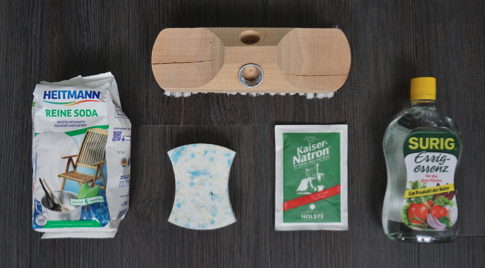In the fourth chapter, we address energy. In the household power supply, heating and water use are the important factors for a sustainable lifestyle.
Why is this relevant?
There are various opportunities for a more sustainable lifestyle, especially in our everyday life at home. Cooking, baking, cleaning, and doing laundry can be done in a more resourceful way, by trying to save water and energy. Furthermore, focusing on avoiding microplastic in the used products does not only have a positive impact on the environment but also on our health and our budget.
WHat can i do?
- Don’t preheat the oven
- Use the oven on fan-assisted
- Use matching pots and lids
- Pretreat stains
- Let the laundry air-dry
- Try to only wash full loads of laundry and dishes
- Use lower temperatures with the washing machine, as well as the dishwasher
40 percent of energy use is caused by kitchen appliances in an average household.
Kitchen
The potential for saving CO2 in our households is by far the highest in the kitchen. Up to 50 percent of used energy can be saved, if you use a lid while cooking. Annualised there should be a saving of 120 kilogramms of CO2 per household. Try to use the stove according to the size of your pots or pans to avoid wasting energy – If a pot is smaller than the stove, unnecessary energy is being wasted.[1]
[1] https://www.fitforfun.de/news/klimafreundliches-kochen-so-sparst-du-energie-in-der-kueche.html
[2] https://nachhaltige-sportbekleidung.de/nachhaltig-waschen/
[3] https://www.studibuch.de/magazin/nachhaltig-putzen-mit-nur-vier-mitteln-die-du-schon-zuhause-hast/
[4] https://www.verbraucherzentrale.de/wissen/umwelt-haushalt/wohnen/waesche-waschen-richtiges-waschmittel-und-ueberfluessige-produkte-13910
Laundry
Not only the production and transport of clothes is causing CO2-emmisions, but also the neccesary washing at home.
It is recommended to reduce the amount of washing cycles: Not every single item of clothing has to be washed after one use. Especially clothes made from natural materials, like wool, take on unpleasant odurs more slowly compared to synthetic fibre and can therfore be worn for a longer time. A further drawback of synthetic material is the occurance of microplastic during a washing cycle. These plastic particles will sooner or later be flushed into the oceans. There they will be consumed by fish and in this way will eventually end up in our food chain and ultimately our bodys. By using special laundry bags (e.g. by Guppyfriend) microplastic is trapped and simultaniously our clothes are being treated more natually. [2]
[2] https://nachhaltige-sportbekleidung.de/nachhaltig-waschen/
The different washing programmes:
30 Grad Celcius ≈ 240 gram CO2
60 Grad Celsius ≈ 750 gram CO2
95 Grad Celcius ≈ 1,4 kg CO2
dryer ≈ 3,5 kg CO2
Cleaning
Most of the common cleaning products contain chemicals that are harming our health and the environment. Therfore, they should be used sparingly and be replaced by compostable alternatives. Even though there is an enormous amount of products available in every drug store, a clean household can be achived by just a few simple products. [3] [4]
[3] https://www.studibuch.de/magazin/nachhaltig-putzen-mit-nur-vier-mitteln-die-du-schon-zuhause-hast/
[4] https://www.verbraucherzentrale.de/wissen/umwelt-haushalt/wohnen/waesche-waschen-richtiges-waschmittel-und-ueberfluessige-produkte-13910
The best household products:

Vinegar: dissolves lime and is desinfecting
Citric acid: also suitable for dissolving lime; can be used as a fabric softener for white clothes
Sodium carbonae: dissolves dirt, fat and incrustations
Sodium bicarbonate: for especially severe staining
